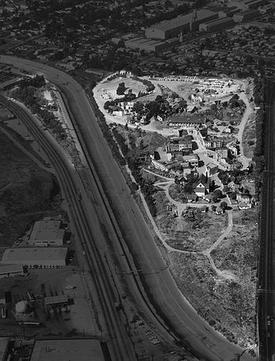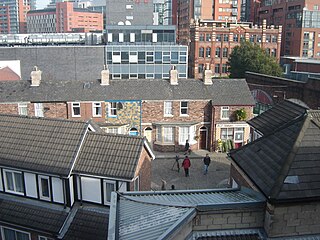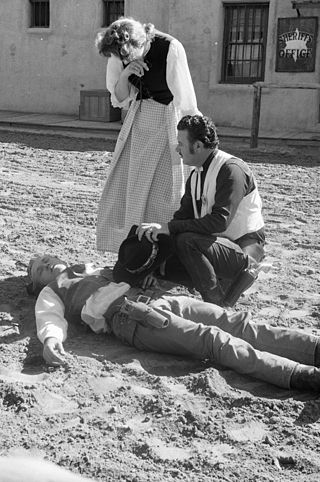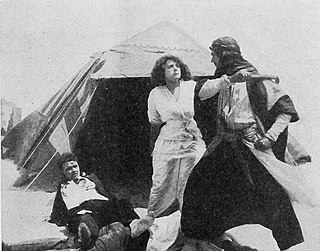Mise-en-scène is the stage design and arrangement of actors in scenes for a theatre or film production, both in the visual arts through storyboarding, visual theme, and cinematography and in narrative storytelling through direction. The term is also commonly used to refer to single scenes that are representative of a film.

Stagecraft is a technical aspect of theatrical, film, and video production. It includes constructing and rigging scenery; hanging and focusing of lighting; design and procurement of costumes; make-up; stage management; audio engineering; and procurement of props. Stagecraft is distinct from the wider umbrella term of scenography. Considered a technical rather than an artistic field, it is primarily the practical implementation of a scenic designer's artistic vision.

Theatrical scenery is that which is used as a setting for a theatrical production. Scenery may be just about anything, from a single chair to an elaborately re-created street, no matter how large or how small, whether the item was custom-made or is the genuine item, appropriated for theatrical use.

Universal City or Universal Studios Complex is an unincorporated area within the San Fernando Valley region of Los Angeles County, California, United States. Approximately 415 acres (1.7 km2) within and around the surrounding area is the property of Universal Pictures, one of the five major film studios in the United States: about 70 percent of the studio's property is inside this unincorporated area, while the remaining 30 percent is within the Los Angeles city limits. Universal City is primarily surrounded by Los Angeles with its northeastern corner touching the city of Burbank, making the unincorporated area a county island.

A sound stage is a soundproof, large structure, building, or room with large doors and high ceilings, used for the production of theatrical film-making and television productions, usually located on a secured movie or television studio property.

The Teatro Olimpico is a theatre in Vicenza, northern Italy, constructed in 1580–1585. It was the final design by the Italian Renaissance architect Andrea Palladio and was not completed until after his death. The trompe-l'œil onstage scenery, designed by Vincenzo Scamozzi to give the appearance of long streets receding to a distant horizon, was installed in 1585 for the first performance held in the theatre, and is the oldest surviving stage set still in existence. The full Roman-style scaenae frons back screen across the stage is made from wood and stucco imitating marble. It was the home of the Accademia Olimpica, which was founded there in 1555.

A backlot is an area behind or adjoining a movie studio containing permanent exterior buildings for outdoor scenes in filmmaking or television productions, or space for temporary set construction.

Principal photography is the phase of producing a film or television show in which the bulk of shooting takes place, as distinct from the phases of pre-production and post-production.

Location shooting is the shooting of a film or television production in a real-world setting rather than a sound stage or backlot. The location may be interior or exterior.

River of No Return is a 1954 American Western film directed by Otto Preminger and starring Robert Mitchum and Marilyn Monroe. The screenplay by Frank Fenton is based on a story by Louis Lantz, who borrowed his premise from the 1948 Italian film Bicycle Thieves. The picture was shot on location in the Canadian Rockies in Technicolor and CinemaScope and released by 20th Century Fox.

A stagehand is a person who works backstage or behind the scenes in theatres, film, television, or location performance. Their work include setting up the scenery, lights, sound, props, rigging, and special effects for a production.
A scene is a dramatic part of a story, at a specific time and place, between specific characters. The term is used in both filmmaking and theatre, with some distinctions between the two.

The Kaufman Astoria Studios is a film studio located in the Astoria neighborhood of Queens in New York City. The studio was constructed for Famous Players–Lasky in 1920, since it was close to Manhattan's Theater District. The property was taken over by real estate developer George S. Kaufman in 1982 and renamed Kaufman Astoria Studios.
A movie ranch is a ranch that is at least partially dedicated for use as a set in the creation and production of motion pictures and television shows. These were developed in the United States in southern California, because of the climate. The first such facilities were all within the 30-mile (48 km) studio zone, often in the foothills of the San Fernando Valley, Santa Clarita Valley, and Simi Valley in the U.S. state of California.
Worldbuilding is the process of constructing a world, originally an imaginary one, sometimes associated with a fictional universe. Developing an imaginary setting with coherent qualities such as a history, geography, and ecology is a key task for many science fiction or fantasy writers. Worldbuilding often involves the creation of geography, a backstory, flora, fauna, inhabitants, technology and often if writing speculative fiction, different races. This may include social customs as well as invented languages for the world.

The sets of the British ITV soap opera Coronation Street have undergone four major and several less significant changes since the first broadcast in December 1960. Originally entirely indoors, in 1968 the original wooden set was moved outside, and shortly afterwards reconstructed in brick. In 1982 the set was entirely rebuilt in a new location. The current set, brought into use in 2013, is based at the ITV Trafford Wharf Studios backlot, MediaCityUK in Trafford.

Tolkien tourism is a phenomenon of fans of The Lord of the Rings fictional universe making media pilgrimages to sites of film- and book-related significance. It is especially notable in New Zealand, site of the movie trilogy by Peter Jackson, where it is credited as having raised the annual tourism numbers.

Corriganville Movie Ranch was a working film studio and movie ranch for outdoor location shooting, as well as a Western-themed tourist attraction. The ranch, owned by actor and stuntman Ray "Crash" Corrigan, was located in the foothills of the Santa Susana Mountains in the Santa Susana Pass area of Simi Valley in eastern Ventura County, California. It was destroyed by wildfires in 1970 and 1979. The site is currently a public park in the City of Simi Valley, called Corriganville Park, and operated by Rancho Simi Recreation and Park District.
There is a long history of television and film in New Jersey, which is considered the birthplace of the movie picture industry.

The Carpet from Bagdad is a 1915 American silent adventure film directed by Colin Campbell and based on Harold MacGrath's 1911 eponymous novel. In the story, Horace Wadsworth, one of a gang of criminals also planning a bank robbery in New York, steals the titular prayer rug from its Baghdad mosque. He sells the carpet to antique dealer George Jones to fund the robbery scheme. But the theft places both men and Fortune Chedsoye, the innocent daughter of another conspirator, in danger from the carpet's guardian.



















